Tooth Extractions
PATIENT REVIEWS
At Cosmetic Dental Specialists in NYC our first attempt is always to maintain the integrity of the dentition by keeping as many natural teeth as possible, while remaining proactive, but if keeping a tooth or teeth creates an unhealthy environment for adjacent teeth, then it may be advisable to extract the “hopeless tooth” at that point. There are many reasons why teeth may need to be pulled. Below is a comprehensive list of why teeth are often extracted:
- Broken, cracked, or extensively decayed teeth can be extraction candidates
- Teeth that are unsuitable candidates for root canal treatment should be extracted.
- Teeth associated with advanced periodontal disease (gum disease) may need to be extracted/pulled.
- Some teeth are extracted because they are malpositioned.
- Impacted teeth are often extracted.
 Malpositioned Teeth
Malpositioned Teeth
 Horizontal Impaction
Horizontal Impaction
PATIENT EDUCATION VIDEOS
Alternatives to Single Tooth Extraction
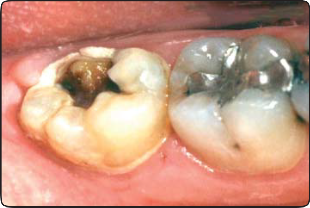 Tooth with severe decay must be removed
Tooth with severe decay must be removed
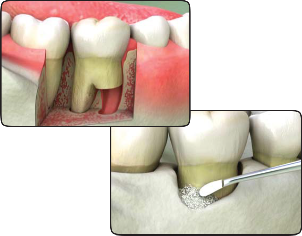 Bone Grafting surgery performed on the tooth
Bone Grafting surgery performed on the tooth
Treatment alternatives
After a tooth has been seriously damaged by decay, a fracture, or periodontal disease, your choices are limited. Some alternatives might be —
- saving a tooth with root canal therapy and a crown.
- saving a tooth with a surgical procedure, such as root amputation or bone grafting.
- delaying treatment.
- removing a tooth that cannot be saved.
Saving the tooth
Sometimes, root canal therapy and a crown can restore a tooth that is broken down by severe decay, hasan infected nerve, or has a crack that has not yet extended through the root.
Other times, surgery is the answer for teeth that can be saved. Root amputation can be an option for removing an infected or damaged tooth root. In some cases of severe periodontal disease, bone grafting, along with other treatments, may save a tooth that is infected and loose.
Delaying treatment
Delaying treatment is a risky alternative because the problem will only get worse. If bone has been lost around the tooth, you’ll lose more bone. If the tooth has an untreated crack, the crack can grow and break the tooth, leading to pain and possibly infection. If the tooth is decayed, the decay will continue to advance as well, and allow bacteria to infect the nerve and jawbone. Delaying treatment also can let infection spread to other teeth, your jaw, and the rest of your body. In some cases, your life can be threatened by infections in the jaw.
Removing the tooth
Sometimes the damage to a tooth is so extensive that the tooth cannot be saved. If this is the case with your tooth, we will recommend an extraction to help you maintain your oral and overall health.
If we must remove a tooth, we often recommend replacing it to preserve the jawbone and stabilize your bite. There are a variety of options for replacing teeth, so we’ll talk with you about the best ones for your situation.
PATIENT EDUCATION VIDEOS
Considering Extraction for Wisdom Teeth
Impacted wisdom tooth has caused decay to form between it and the second molar


Extracting wisdom teeth
For many people, the best treatment for wisdom teeth is to remove them. This treatment helps prevent future dental problems and maintain a healthy mouth and smile.
Wisdom teeth can cause problems
Your last molars, called the third molars or wisdom teeth, typically begin to come in (erupt) during the late teens or early twenties. When they don’t have room to grow in properly, they are considered impacted. This can cause serious problems:
- A very painful infection, called pericoronitis, can affect a partially erupted wisdom tooth and the surrounding gums. This infection can spread into the face and jaw.
- When a wisdom tooth tries to erupt at an angle, it can cause decay in the neighboring tooth. This happens because wisdom teeth are nearly impossible to keep free of plaque, and the area between the two teeth becomes a trap for the bacteria in plaque that cause tooth decay.
- Additional bacteria in plaque cause periodontal (gum) disease, which may start near the wisdom teeth and spread throughout the mouth.
- A fluid-filled sac called a cyst may develop around an impacted tooth. A cyst can destroy a great deal of bone in the jaw before it’s noticed.
Diagnosis and treatment
To determine if extracting wisdom teeth is right for your situation, we’ll do a thorough examination, which typically includes x-rays.
It’s often better to remove wisdom teeth early, while their roots are still small, even before the teeth have come in through the gums. This allows for easier removal, fewer complications, and faster healing.
PATIENT EDUCATION VIDEOS
Alternatives to Wisdom Tooth Extraction
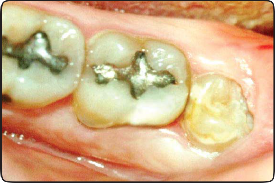 Partially erupted wisdom tooth
Partially erupted wisdom tooth
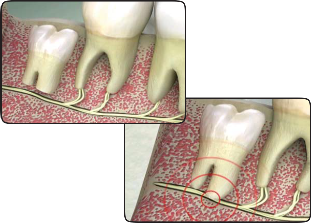
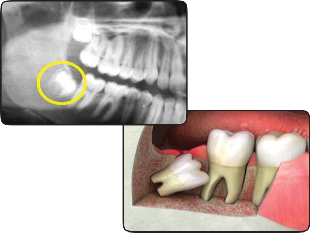
Treatment alternatives
When we’re considering wisdom teeth, there are only two possibilities:
- Keep them.
- Remove them.
Keeping wisdom teeth
A few lucky people are able to keep their wisdom teeth and take proper care of them. In many cases, though, there isn’t enough room in the jaw for wisdom teeth to come in properly. When a tooth cannot come in properly, we call it an impacted tooth.
Removing wisdom teeth
Removing wisdom teeth is sometimes the best choice for keeping your mouth healthy. If you delay extracting a wisdom tooth that should come out, serious problems can result, including —
- painful infection of the gums.
- tooth decay.
- periodontal disease.
- destruction of the jawbone.
You should also know that it’s often better to remove wisdom teeth while their roots are still small. Early removal can make the procedure easier and the healing process faster. Sometimes this means that wisdom teeth should be removed even before they have come in through the gums. If you wait too long before having wisdom teeth extracted, the roots can grow around or close to a nerve in the jaw, which may then be damaged during extraction. This could leave your lip and chin permanently numb.
For all these reasons, we often recommend extracting wisdom teeth early to help you keep your mouth and smile healthy.
PATIENT EDUCATION VIDEOS
Diagnosing tooth decay



When an extraction is necessary
When a tooth is severely decayed and cannot be saved, extracting it can be the best choice for relieving pain and preventing the spread of infection.
Most decayed teeth can be saved
Most decayed teeth can be treated successfully with a filling or crown. But for these treatments to work, there must be enough healthy tooth structure above the jawbone to support the restoration.
For example, a crown is often used to cover, protect, and restore a tooth that’s been damaged by decay. The crown attaches to the part of the tooth that’s above the bone, so an adequate amount of tooth structure must remain to hold the crown securely.
Some teeth cannot be saved
If too much of your tooth has been severely damaged by decay, there isn’t enough healthy tooth structure left to hold a restoration. In this case, we may have no choice but to remove what remains of the tooth.
Diagnosis and treatment
To determine if an extraction is right for your situation, we’ll perform a thorough exam, which typically includes x-rays.
If the tooth cannot be saved, it’s important to extract it as soon as possible to prevent infection in the tooth and jawbone. With modern dental techniques, the procedure should be a comfortable one for you. In many cases, we also recommend replacing an extracted tooth to preserve the jawbone and stabilize your bite, so we’ll talk with you about your replacement options.
PATIENT EDUCATION VIDEOS
Dry Socket
 Dry Socket
Dry Socket

Dry socket is an inflammation that occurs when the blood clot that forms in the socket after a tooth extraction becomes dislodged or does not form properly.
The clot is necessary to protect the socket, stop bleeding, promote the development of new bone and gum tissues, and prevent pain.
However, when the clot is lost prematurely, the inflamed socket and underlying nerves and bone are exposed.
Symptoms
The symptoms of dry socket are a severe throbbing pain that does not respond to normal pain medications. It starts one to four days following an extraction, and the pain may radiate into your ear. You may also notice a foul odor or taste in your mouth.
Causes and prevention of dry socket
After your tooth has been extracted, we’ll give you complete instructions about caring for your mouth. Following them exactly will help you avoid dry socket. It’s especially important to avoid certain behaviors that can cause the premature loss of a blood clot, particularly within the first 24 hours after an extraction.
- Do not touch the extraction site with your fingers or tongue.
- Do not rinse the area during the first 24 hours after extraction. After that time, follow our instructions for when and how to rinse.
- Do not smoke or use tobacco.
- Do not suck through a straw.
- Avoid sneezing or coughing when possible.
- Avoid carbonated, hot, or alcoholic drinks.
Diagnosis and treatment
Call our office right away if you notice any symptoms of dry socket. To confirm the diagnosis, we’ll talk with you about your symptoms and perform a thorough examination. The exam may include an x-ray of the extraction site.
Treatment for dry socket often includes a gentle rinsing of the socket with a medicated solution. We may also pack the site with a gauze dressing that contains a soothing anesthetic. You’ll probably need to return to our office several times over the next week or two, so we can change the dressing and monitor the effectiveness of your pain medications.
Prompt diagnosis and treatment will allow the blood clot to fill back in, and the area will begin to heal normally once again.
Diagnosing Fractured Tooth
 Severely fractured tooth
Severely fractured tooth

When an extraction is necessary
When the root of a tooth is fractured and cannot be saved, extracting the tooth can be the best choice for relieving pain and preventing infection.
Some fractured teeth cannot be saved
Many cracked teeth can be treated successfully with root canal therapy and a crown, especially those whose cracks are located above the gumline only. However, these treatments may not save the tooth when a fracture has extended into the root.
Diagnosis and treatment
You may suspect you have a fractured tooth because–
- the tooth is sensitive to hot or cold.
- you feel a sharp pain when you chew.
To determine if an extraction is right for your situation, we’ll perform a thorough exam, which typically includes x-rays. However, x-rays may not reveal the crack, so we may analyze your bite to isolate the problem or examine your gums for signs of the fracture.
If the tooth cannot be saved, it’s important to extract it as soon as possible to prevent pain and infection in the tooth and jawbone. With modern dental techniques, the procedure should be a comfortable one for you. In many cases, we also recommend replacing an extracted tooth to preserve the jawbone and stabilize your bite, so we’ll talk with you about your replacement options.
PATIENT EDUCATION VIDEOS
Considering extractions due to Periodontitis
 X-ray below showing advanced bone loss due to gum disease
X-ray below showing advanced bone loss due to gum disease
 X-ray below showing optimal bone loss on healthy patients
X-ray below showing optimal bone loss on healthy patients

When an extraction is necessary
When too much bone around a tooth has been lost due to severe periodontal disease (also called periodontitis), sometimes the best treatment is to remove the tooth to maintain the health of your mouth.
Periodontal disease causes bone loss
Teeth are held in place by the height and shape of the jawbone, but when teeth and gums are infected by the bacteria that cause periodontal disease, the disease process begins to destroy the bone that surrounds the teeth.
Left untreated, periodontal disease destroys so much bone that there is not enough support for the teeth. In severe cases, the teeth become very loose and cannot be saved.
Diagnosis and treatment
To determine if an extraction is right for your situation, we’ll do a thorough examination, which typically includes x-rays. In advanced gum disease, sometimes called periodontitis, x-rays show us low and uneven bone levels around the teeth. The condition is especially obvious when compared to x-rays of a healthy mouth, in which the bone comes up high around the necks of the teeth.
Many times we can save teeth. Aggressive periodontal therapy, frequent periodontal maintenance appointments in our office, and consistent homecare can halt the progression of periodontal disease and stop the bone loss. Sometimes we also recommend periodontal surgery to save teeth.
However, if your teeth continue to loosen and the destruction persists, our only option will be to remove the affected tooth. It’s important to extract a tooth that cannot be saved as soon as possible to prevent the spread of infection.
We often recommend replacing an extracted tooth to preserve remaining jawbone and stabilize your bite, so we’ll talk with you about your replacement options.
PATIENT EDUCATION VIDEOS
Post-Op Instructions for an Extraction
Follow these instructions carefully to ensure the successful healing of your tooth extraction.
When to call us
It is normal to experience some discomfort for several days after a tooth extraction, but call us right away if you have:
- Heavy or increased bleeding
- Pain or swelling that increases or continues beyond two or three days
- A bad taste or odor in your mouth
- A reaction to the medication
During the first 24 hours
It is important that a blood clot forms on the extraction site to stop bleeding, reduce pain, and speed healing. To protect the clot and avoid the pain of dry socket:
- Bite on a gauze pad firmly for 30-60 minutes. Blood and saliva mix in the mouth and make it look like there is more bleeding than there really is. Some oozing is normal; however, after 1 hour, repeat with a clean gauze pad if oozing is profuse. The site could ooze for as long as 24 hours.
- Don’t spit, and don’t suck on candies or through a straw.
- Don’t rinse your mouth, and don’t brush or floss next to the site.
- Don’t smoke or use tobacco. Avoid tobacco for at least 72 hours because it slows healing.
- Don’t sneeze or cough, so have sinus or allergy medication on hand if necessary.
- Limit yourself to calm activities, and elevate your head with pillows when you lie down to reduce bleeding.
- Don’t drink hot, carbonated, or alcoholic drinks, and avoid hot or spicy foods.
To control discomfort, take pain medication before the anesthetic has worn off or as recommended.
To keep swelling to a minimum, use an ice bag over the area, 20 minutes on and 20 minutes off.
When the numbness has worn off completely, drink lots of fluids and eat only soft nutritious foods, chewing on the opposite side.
After the first 24 hours
Begin to eat normally as soon as it’s comfortable.
Resume brushing and flossing, but clean gently around the site for about a week.
If antibiotics were prescribed, continue to take them for the indicated length of time, even if all symptoms and signs of infection are gone.
Reduce soreness or swelling by applying moist heat. Swelling usually starts to go down after 48 hours.
Further reduce swelling by rinsing your mouth very gently with warm salt water. Use about one teaspoon of salt per glass of warm water. Rinse two to three times a day for the week following the extraction.
PATIENT EDUCATION VIDEOS
Ridge Preservation
 The jawbone shrinks when a tooth is missing
The jawbone shrinks when a tooth is missing


Bone grafting techniques can sometimes be necessary to preserve the ridge of jawbone
The procedure
In many cases, a ridge preservation procedure takes place when a tooth is extracted. During the procedure, we will make sure that the area is completely numb to keep you comfortable. You shouldn’t feel any pain at all. If you do, we’ll stop and give you more anesthetic.
We prepare the bone grafting material, which may be your own bone or bone from another source. After the tooth is extracted, we gently clean and disinfect the tooth’s socket and then fill it with the grafting material.
In some cases, we may place a special membrane over the graft to make sure the bone and gum tissues heal properly. Last, we may close the socket with a few stitches.
The benefits of ridge preservation
A bone grafting procedure preserves the shape and strength of your jawbone. The procedure fills in the socket from which the tooth was removed and helps new bone to grow.
This helps slow the shrinkage of the jawbone that naturally occurs when teeth are missing. Jawbone shrinks when teeth are lost because the bone that supported the teeth is no longer stimulated by chewing.
Ridge preservation techniques help maintain your jaw’s healthy appearance and make some tooth replacement options possible and attractive.
PATIENT REVIEWS
My husband and I both needed extensive dental work…and so, we actually flew to New York to see Dr. Edalat, after meeting one of his students who had raved about Dr. Edalat and his office. Both my husband and I feel and look so much better after our treatment. We wouldn’t dream of seeing any other dentist ever again!”
Louise C. – Kent, England

 Google
Google Yahoo
Yahoo Yelp
Yelp Insider Pages
Insider Pages Healthgrades
Healthgrades CitySearch
CitySearch Wellness
Wellness




